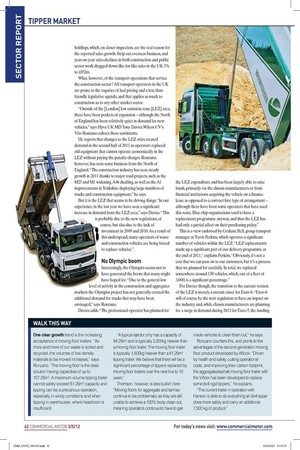WALK THIS WAY
Page 33

If you've noticed an error in this article please click here to report it so we can fix it.
One clear growth trend is the increasing acceptance of moving floor trailers. “As more and more of our waste is sorted and recycled, the volumes of low density materials to be moved increases,” says Ronzano. “The moving floor is the ideal solution having capacities of up to 107.25m3. A maximum volume tipping trailer cannot safely exceed 61.25m3 capacity and tipping can be a precarious operation, especially in windy conditions and when tipping in warehouses, where headroom is insufficient. “A typical ejector only has a capacity of 84.25m3 and is typically 2,000kg heavier than a moving floor trailer. The moving floor trailer is typically 1,500kg heavier than a 61,25m3 tipping trailer. We believe that there will be a significant percentage of tippers replaced by moving floor trailers over the next five to 10 years.”
Thomson, however, is less bullish here: “Moving floors for aggregate and tarmac continue to be problematic as they are still unable to achieve a 100% body clean out, meaning operators continue to have to get inside vehicles to clean them out,” he says.
Ronzano counters this, and points to the advantages of the second-generation moving floor product developed by Wilcox: “Driven by health and safety, cutting operational costs, and improving their carbon footprint, the aggregate/asphalt moving floor trailer with the V-floor has been developed to replace some 8x4 rigid tippers,” he explains.
“The current trailer in operation with Hanson is able to do everything an 8x4 tipper does more safely and carry an additional 7,500 kg of product.”










































